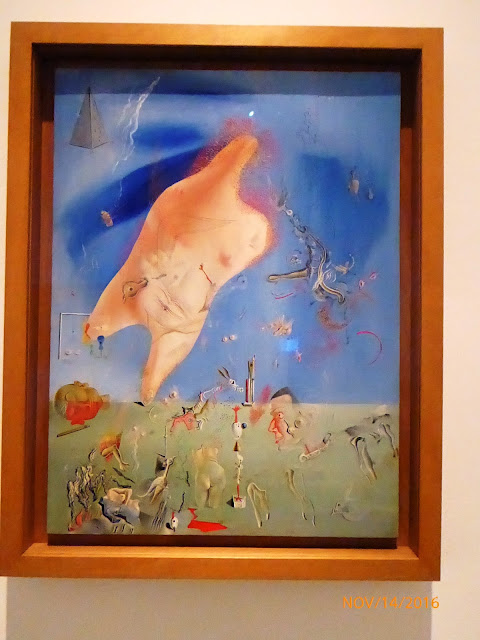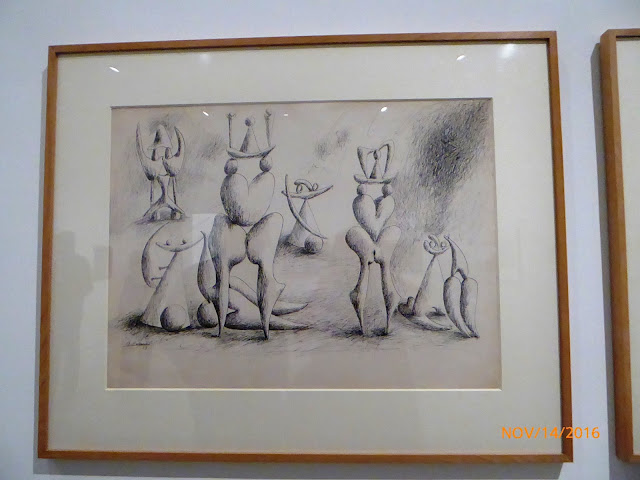The museum is on the site of the first hospital in Madrid, which was built in the 16th century. The site was in continuous use as a hospital until 1969. The 265,000 square foot museum is mostly dedicated to 20th century Spanish art. We visited only one collection, The Irruption of the 20th Century: Utopias and Conflicts.
On entry we were greeted by these three individuals -
a gypsy woman
this rather handsome man
and this laughing child, who reminds me of the daughter of a friend
this had to be one of my favourite pictures just because of it's title
- Dust Growing - I can relate
Joan Miro painting
Head of a Smoker - Miro
Flamenco Dancers
Dali
Sterile Efforts - Dali
Flamenco
Pierrot playing the guitar - Dali
Motherhood
Matador and Bull
Mule head
Cosmic Composition - Dominguez
Guanche Cave - Dominguez
Face of the great Masturbator - Dali
Details up close
Architectural Angelus of Millet
Invisible Man
Portrait of Joella - Dali and Man Ray
Endless Enigma - Dali
Premonition of Civil War - Dali
We then moved on to the Picasso section, but alas, no photos were allowed. The piece de resistance of the Picasso collection was his Guernica painting.
Guernica is a mural-sized oil painting on canvas by Spanish artist Pablo Picasso completed in June 1937. The painting, which uses a palette of gray, black, and white, is regarded by many art critics as one of the most moving and powerful anti-war paintings in history. Standing at 11 ft 5 in tall and 25 ft 6 in wide, the large mural shows the suffering of people wrenched by violence and chaos. Prominent in the composition are a gored horse, a bull, and flames.
Guernica is a town in the province of Biscay in Basque Country. During the Spanish Civil War, it was regarded as the northern bastion of the Republican resistance movement and the center of Basque culture, adding to its significance as a target. The Republican forces were made up of assorted factions (Communists, Socialists, Anarchists, to name a few) with differing goals, but united in their opposition to the Nationalists.
About 16:30 on Monday, 26 April 1937, warplanes of the German Condor Legion, bombed Guernica for about two hours. Germany, at this time led by Hitler, had lent material support to the Nationalists. The Nationalists, led by General Francisco Franco, sought a return to pre-Republican Spain, based on law, order, and traditional Catholic values.
Guernica was a quiet village. The nearest military target of any consequence was a factory on the outskirts of the town, which manufactured various war products. The factory went through the attack unscathed. Thus, the motivation of the bombing was one of intimidation.
Accounts state that the town's inhabitants were congregated in the center of town, as it was market day, and when the bombardment commenced, were unable to escape because the roads were full of debris and the bridges leading out of town had been destroyed. Because a majority of the town's men were away, engaged in fighting on behalf of the Republicans, the town at the time of the bombing was populated mostly by women and children.
At the request of the Spanish Nationalists, Picasso, living in exile in Paris since 1934, was commissioned to create a mural for the 1937 Paris International Exposition. Picassos first subject matter for the painting was his usual theme of the artist's studio. After hearing about and seeing pictures of the devastation at Guernica, he changed his subject matter.
Upon completion, Guernica was initially exhibited in July 1937 at the Spanish Pavilion at the 1937 World's Fair and then at other venues around the world. The touring exhibition was used to raise funds for Spanish war relief. The painting became famous and widely acclaimed, and it helped bring worldwide attention to the Spanish Civil War.
At Picasso's request, the safekeeping of the piece was entrusted to the Museum of Modern Art (MoMA) in New York City, as it was Picasso's expressed desire that the painting should not be delivered to Spain until liberty and democracy had been established in the country. In Feb 1974, during Vietnam war protests, the painting was defaced with red spray paint. The paint was removed with relative ease from the varnished surface.
Despite requests, Picasso continued to refuse to allow the return of the painting to Spain until the Spanish people again enjoyed a republic. Picasso died in 1973, never having returned to Spain since his exile. Franco, ten years Picasso's junior, died two years later, in 1975. After Franco's death, Spain was transformed into a democratic constitutional monarchy, ratified by a new constitution in 1978. However, MoMA was reluctant to give up one of their greatest treasures and argued that a monarchy did not represent the republic that had been stipulated in Picasso's will as a condition for the painting's return. Under great pressure from a number of observers, MoMA finally ceded the painting to Spain in 1981.
Guernica has become a universal and powerful symbol warning humanity against the suffering and devastation of war. Moreover, the fact that there are no obvious references to the specific attack has contributed to making its message universal and timeless. (Thanks to Wikipedia for the info)
It is a fascinating study once you understand the story behind it.
This does not do it justice.
Guernica - Picasso






















































No comments:
Post a Comment